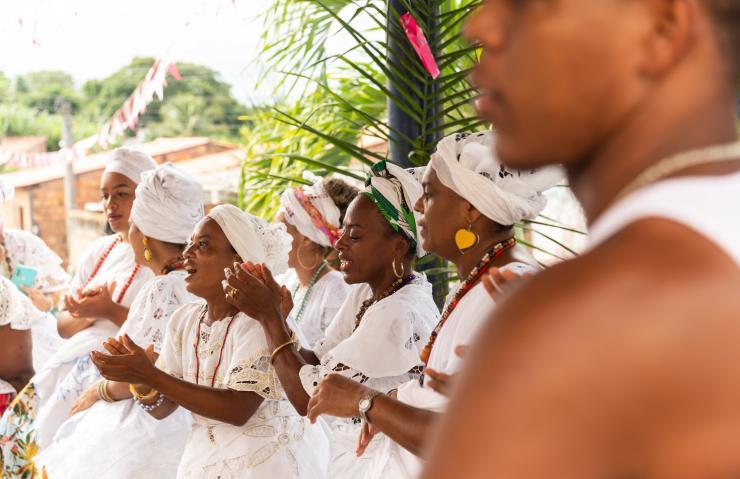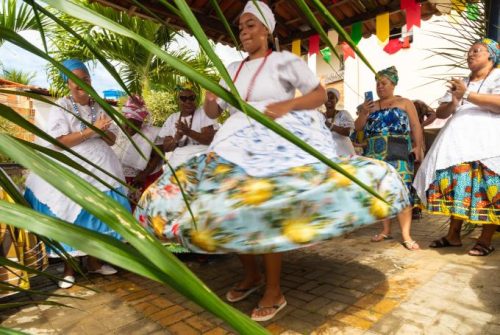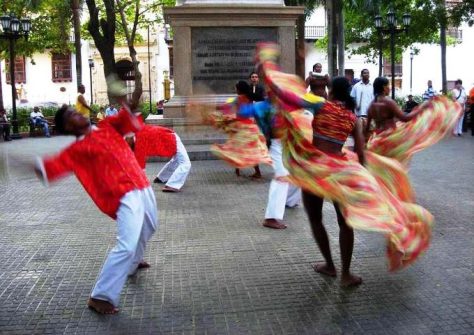Brazil. The Magic Dance.

The marambiré is the most authentic African ritual of all Amazonia. Its rhythm is similar to that of the candomblè, whose costumes, musical instruments, coloured ribbons and rhythm are reminiscent
of African heritage.
It is a display that goes back to the time of slavery. It has been celebrated for almost two centuries and is one of the major popular feasts of the municipality of Alenquer in Parà State in the heart of Amazonia.The marambiré is a sacred rite that is fascinating, dynamic, lively, enchanting, seductive and full of evolving elements. It is marvellous in its human and divine creative imagination and in its mystical power over nature.
It is the greatest sign of the resistance, the cultural life and the desire for freedom of all the black people of Amazonia.

Candomble members dancing and singing. The dance reflects the African origins of the habitat where the culture of Mother Africa developed. 123rf
As a whole, it is a celebration of ‘confraternisation’, a great expression of the humanity of the black community that is understood by retracing the history of the methods of production common in Africa (horticulture) and the memory of the ancestors taken from their country and their cultural context, chained up and thrown into the holds of ships. Many died during the crossings and their bodies were thrown into the Atlantic Ocean. This is why the feast of the marambiré concludes its cycle with a procession along the river where, to the sound of music, thousands of coloured flowers are placed.
It is believed that the waters of the sea and the river are scared as they constitute the cemeteries of their relatives and friends.
The marambiré is the deepest expression of syncretism among the traditions coming from the African continent, especially the Congo, Angola and Mozambique, and the mythology of the Amazonian flora and fauna. It is now part of the historical, cultural, social, political, philosophical and religious heritage of the municipality of Alenquer and the whole of Latin America.
The dances
In the marambiré ritual, dancing is of considerable importance. It is a sort of dancing mime with well-defined rhythms. It is a dance inspired by the coronation of the black kings that the slaves elected in certain periods. Following the oral tradition of ancient beliefs and customs, the marambiré players do not take part in the dance. They accompany an exuberant choreography which produces a spectacle of rare beauty and imagination. As people dance in a circle, all the living strength and flexibility of the black body is visible.
The marambiré is majestic and solemn; as they perform the steps, the dancers exhibit a wealth of movement.
The songs consist of short phrases, simple and enchanting, a mixture of African languages and Portuguese.
The dance reflects the African origins of the habitat where the culture of Mother Africa developed.Those who take part in the marambiré dance go out on the roads in lines and circles, dancing in the squares and internal courtyards of private houses. However, strictly speaking, tradition requires that the dance take place only at the houses of descendants of slaves up to the fifth generation. The dancers, instead, must be directly related to the third degree.

Brazil. The marambiré is majestic and solemn; as they perform the steps, the dancers exhibit a wealth of movement. Pixabay
The dancing group is composed of eighteen first-born men and seven married women called contra-mestre. The musicians are also seven, besides the King and Queen of the Congo who are considered as one, ‘a single and absolute being’. The Queen of the Congo is the most important person in the dance. Dressed very discreetly, she receives the expressions of respect and affection offered by her ‘subjects’. To the sound of drums, tamborins (tambourines), atabaques, violins and pandeiros, the lwulum or ludum similar to the carimbò and the marabaixo is then performed. The Queen of the Congo then dances with such complete vigour that it grips those present to whom – the men, naturally – she launches a subtle and knowing challenge by exhibiting versatile and attractive steps which, to the sound of appropriate music, involve the whole group and the audience.

Amazon Forest. The feast of the marambiré concludes its cycle with a procession along the river where, to the sound of music, thousands of coloured flowers are placed. Pixabay
Those flattered by the crown of the king or the queen cannot turn down the invitation: in the final analysis, their majesties are sacred people worthy of respect and must not be disappointed. It is a song of sorrow and lament but also a song of joy and the hope to live free like the birds; the marambiré is not only folklore but a concentrated process of a homogeneous and unified culture that celebrates the wisdom and the struggle of the black communities of Amazonia. (Open Photo:123rf)
Lucas Moraes



